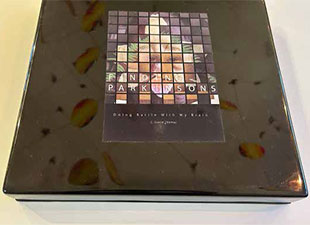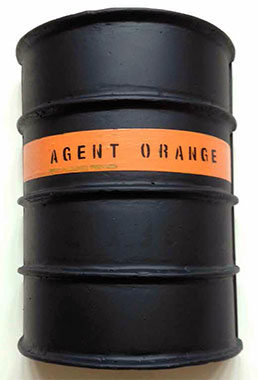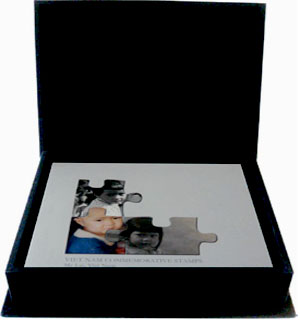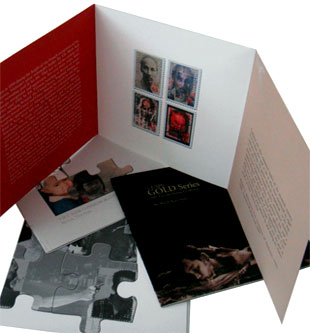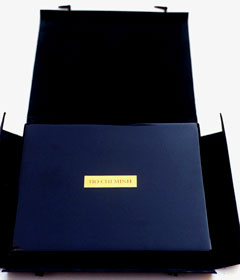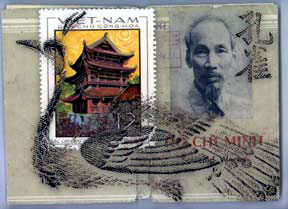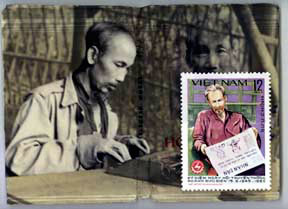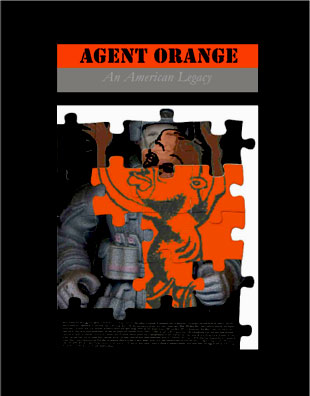
|
C. David Thomas ~ Massachusetts |
Share this page: |
| Statement: " A contemporary American painter and printmaker, C. David Thomas began exhibiting his art shortly after his release from active duty in Vietnam with the United States Army. He began his military duty in Pleiku with the 20th Engineer Battalion and served as a combat artist and as a soldier. Since then he has returned to Vietnam on many occasions, both as a working artist and as director of the Indochina Arts Partnership, an association which promotes artists' links between America and Vietnam." | |
| David C. Thomas interview in the Hanoi Times | |
Finding Parkinson's 45 pages; presented in a 9 x 12 x 1.5” lacquer box made in Vietnam with linen bag. Printed on both Rives BFK paper and custom made mulberry paper from Vietnam. Includes 15 pages of photographs taken from the exhibition by the same name. Signed by Dan Monroe, David Rose and C. David Thomas. Promo Material: "This book is the result of David being diagnosed with Parkinson’s Disease in 2015. The cause of this is most likely his exposure to the deadly defoliant Agent Orange while stationed in Pleiku, South Vietnam in 1969-70. “In this book he has combined selfies, MRI images of his brain and lithographs he made mostly in the 1980s. … It also contains two essays by Dan Monroe, retired Director of the Peabody Essex Museum and one by Dr. David Rose, from Harvard School of Education. “David Thomas has also written an essay about how this has effected him and his family and friends” C. David Thomas essay excerpt: “In 2015, I went to my primary care doctor because I was feeling increasingly confused by what was happening to my body. I lost my sense of taste and smell many years before but now I began dragging my feet, walking like a duck and my handwriting was becoming smaller and smaller. I put all of these symptoms into www.ebmd.com and it came up that I had a 90% chance of having Parkinson’s disease … “My life since my diagnosis has been one of day-to-day uncertainty about my cognitive and physical changes. The most difficult thing about having this disease is the uncertainty of the number and type of symptoms I may develop and the speed and intensity of the increase of symptoms. …” |
|
Agent Orange Subjects covered include
Prospectus: "The subject of this sixty-one page artist’s book is Agent Orange, the deadly dioxin contaminated defoliant used in Vietnam between 1961 and 1971… |
|
Postage Due Forever Stamps 6.75 x 7.25 x 2.5"; 14 tri-fold booklets. Printed on Innova short grain, 200 gram, natural white soft texture duo paper. Printed from a Hewlet Packard Photosmart Pro B9180 using archival ink. Presented in a black linen clamshell box handmade by craftsmakers in Hanoi, Viet Nam. Ribbon and velcro closure. Illustrated title label on box cover. Postage mage thumbnails on interior of box. C. David Thomas, Introduction: "This book contains twelve sets of stamps with images that cannot be found on U.S. Postal Service stamps. These include, among other, images of Vietnam's leader Ho Chi Minh working with U.S. soldiers during WWII, images of American prisoners of war drawn by a former North Vietnamese soldier/artist, images of Agent Orange victims, images of the My Lai massacre in South Vietnam, images of a badly burned young girl fleeing from her village which had just been napalmed, and images of Hiroshima and Nagasaki, Japan, after the US nuclear bombing of those densely populated cities. "I never really thought much about the importance of how we chose what images to place on our stamps until one day in 1995, when I went to post office and asked for an interesting stamp. The woman behind the counter handed me a sheet of the recently issued Richard Nixon stamp. This stamp was issued only twenty years after he was forced to resign in disgrace as the 37th President of the United States. Needless to say, I handed them back to her with some choice words. "The next time I was to think about stamps was in 1996, when I went to the philately society in Hanoi, Viet Nam, while doing research for a book on President Ho Chi Minh. Of course I found dozens of stamps with the image of Ho Chi Minh as well as many other world leaders including Vladimir Lenin, Joseph Stalin, Karl Marx, Mao Tse Dung, and Mahatma Gandhi. Other stamps I found depicted Vietnamese war and sports heroes, butterflies, frogs, flowers, and even a 1966 stamp depicting the shooting down of the 1,500th US aircraft brought down over North Viet Nam and one with the image of Norman Morrison, the man who immolated himself outside Robert McNamara's office at the Pentagon. "Just a few days before the US Post Office issued Robert Indiana's LOVE stamp in 1973, the US heavily bombed the densely populated city Hanoi killing hundreds of innocent Vietnamese civilians. "For many summers during the 1950s and 60s my sister Karen and I, in order to escape the summer heat, would spend hours upon hours swimming and playing at Raymond Pond, ME. On a similarly hot summer day in June of 1968, Kim Phuc was playing with her two brothers in a tiny hamlet just north of Saigon when a US fighter jet dropped napalm on them, killing her two brothers instantly and burning the skin off her back. "I have begun to understand the real power of this little jewel which may be the smallest form of propaganda available to all governments.These miniature posters travel all over the world spreading their message of the country of issue. Not only is it important what we decide to include on our stamps but possibly more important is what we chose not to put on our stamps. "The images in this book were selected because they depict important events in American history which seldom appear in our historical documents. They are intended to force you to think and ask questions about our history as well as our future. If we refuse or ignore to face these facts, how can we ever have a clear understanding of our history? And won't we simply continue to repeat our mistakes? My Lai will be come Abu Ghraib and on and on." |
|
|
HO CHÍ MINH 13.25 x 11.25 x 2.25"; 118 pages: 59 text pages, 59 image pages. Images printed from a Hewlett-Packard DeskJet 970Cse using archival ink. Letterpress printed in Monotype Bembo by Wolfe Editions in Portland, Maine. Printed on Vietnamese Do (mulberry) paper handmade in Dong O Village in northern Vietnam. Text pages varnished to make the paper translucent. Laid in a lacquer box handmade by craftsmakers in Thanh Tri Village near Hanoi. Box laid in a handmade silk slipcover also custom made in Vietnam. Copy edited by Gloria Lee. Numbered and signed by C. David Thomas and Charles Fenn. Colophon: "Each lacquer box is made in the centuries-old method of using wood covered with a coarsely woven silk followed by thirteen coats of lacquer. Between coats of lacquer the box is hand sanded with very fine water sandpaper until the final layer, which is done by using charcoal powder and bare hands". Prospectus: "In spite of the fact that Ho Chi Minh is on nearly everyone’s short list of the most important leaders of the twentieth century, the last book published on Ho Chi Minh in the United States, before William Duiker's book Ho Chi Minh: A Life was released in the fall of 2000, was Charles Fenn’s 1973 biography titled Ho Chi Minh. Before that the only other biography written on Ho Chi Minh by an American author was David Halberstam’s 1971 book titled HO. "After more than twenty-five years this book by biographer Charles Fenn and artist David Thomas is a result of the collaboration of these two men uniquely qualified to undertake this important project. “This book includes passages from a fictional ‘diary.’ As far as we know, Ho never kept a prose diary. The purpose intended in this work of imaginative reconstruction is to evoke a sense of his personal engagement with the events of his time. The ‘diary’ is based on historical documents but should not be taken literally. Although fictional, the ‘diary’ is based on factual information found at the bottom of each page. Also included are passages from Prison Diary, a collection of poems written by Ho Chi Minh while he was in prison in China in 1942-43, as well as two stories told by Mr. Vu Ky and Mr. Dinh Duong Dinh, two of Ho’s closest friends, and poems by several of Vietnam’s leading poets." |
|
| C. David Thomas SOLD / Out of Print Titles: | |
Agent Orange 9.25 x 11.125 x 2.75" closed; 30 x 24" assembled; 20 puzzle pieces. Printed using archival paper and ink on an HP Photosmart Pro B9180 printer. Pieces mounted on felt and handcut. A 4-page full-color pamphlet (7 x 9") contains the colophon, edition information (including images of all 5 variants), and the artist's signature. Housed in black linen box made by artisans in Hanoi, Vietnam. Illustrated title label on lid. Agent Orange is one in a series of five artist's puzzle books by C. David Thomas. Each in the series is an edition of 10. Each deals with composite images that come from the Viet Nam conflict. C. David Thomas, introduction: "Agent Orange is the code name for a herbicide and defoliant used by the US military in its Herbicidal Warfare program during the Vietnam War. "According to the post-war Vietnamese government, 4.8 million Vietnamese people were exposed to Agent Orange, resulting in 400,000 deaths and disabilities, and 500,000 children born with birth defects. "From 1961 to 1971, Agent Orange was by far the most widely used of the so-called 'Rainbow Herbicides' employed in the herbicidal warfare program. During the production of Agent Orange (as well as Agents Purple, Pink, and Green) dioxins were produced as a contaminant, which have caused health problems for those exposed during the Vietnam War. Agents Blue and White were part of the same program but did not contain dioxins." |
|
Page last update: 01.24.2025
Home | About Us | Contact Us | New Arrivals | Fine Press & Artists' Books | Broadsides |Resource Books | Order/Inquiry
Copyright © 2021 Vamp & Tramp, Booksellers, LLC. All rights reserved.
